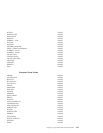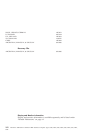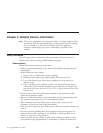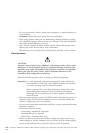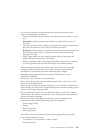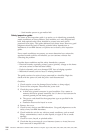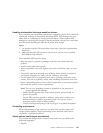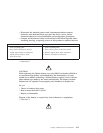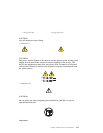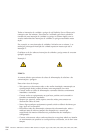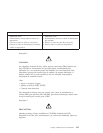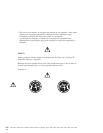Handling electrostatic discharge-sensitive devices
Any computer part containing transistors or integrated circuits (ICs) should be
considered sensitive to electrostatic discharge (ESD). ESD damage can occur
when there is a difference in charge between objects. Protect against ESD
damage by equalizing the charge so that the machine, the part, the work mat,
and the person handling the part are all at the same charge.
Notes:
1. Use product-specific ESD procedures when they exceed the requirements
noted here.
2. Make sure that the ESD protective devices you use have been certified
(ISO 9000) as fully effective.
When handling ESD-sensitive parts:
v Keep the parts in protective packages until they are inserted into the
product.
v Avoid contact with other people.
v Wear a grounded wrist strap against your skin to eliminate static on your
body.
v Prevent the part from touching your clothing. Most clothing is insulative
and retains a charge even when you are wearing a wrist strap.
v Use the black side of a grounded work mat to provide a static-free work
surface. The mat is especially useful when handling ESD-sensitive devices.
v Select a grounding system, such as those listed below, to provide protection
that meets the specific service requirement.
Note: The use of a grounding system is desirable but not required to
protect against ESD damage.
– Attach the ESD ground clip to any frame ground, ground braid, or
green-wire ground.
– Use an ESD common ground or reference point when working on a
double-insulated or battery-operated system. You can use coax or
connector-outside shells on these systems.
– Use the round ground-prong of the ac plug on ac-operated computers.
Grounding requirements
Electrical grounding of the computer is required for operator safety and
correct system function. Proper grounding of the electrical outlet can be
verified by a certified electrician.
Safety notices (multi-lingual translations)
The caution and danger safety notices in this section are provided in the
following languages:
v English
Chapter 4. Related Service Information 189



